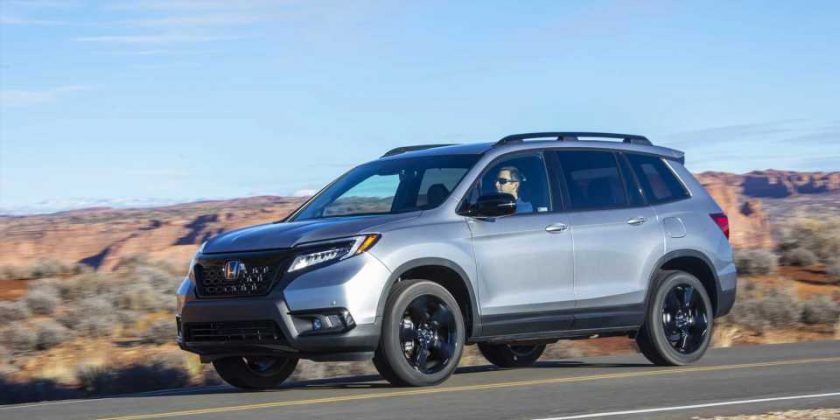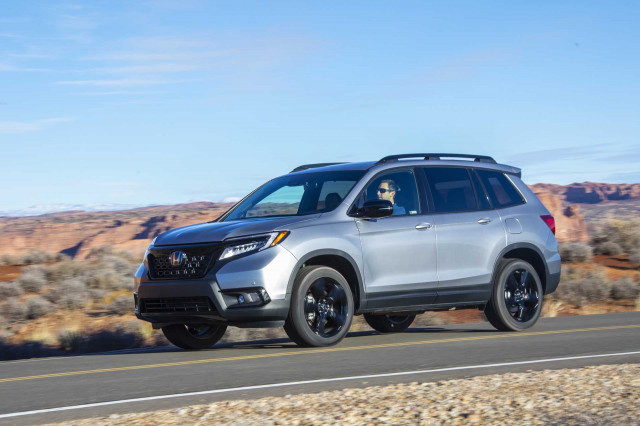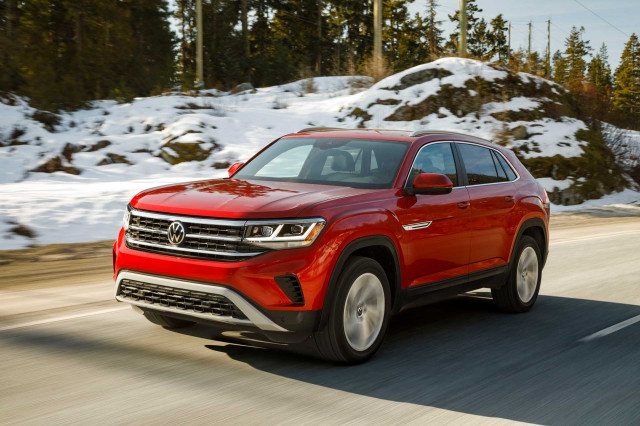2020 Honda Passport
The 2021 VW Atlas Cross Sport and the 2020 Honda Passport are classic spin-offs. Like “Rhoda” and “The Jeffersons,” they have plenty to recommend them in their own right, even over the three-row SUVs that spawned them.
Which one deserves to come back for next season? Both two-row crossovers tip our ratings scales in the right direction, but it’s the Honda Passport that scores the win in the TCC Rating, our version of the Nielsens. It’s a close race, though, since both fare very well in cargo space, passenger seating, and safety gear.
In styling, the two-row 2020 VW Atlas Cross Sport falls behind the somewhat cleaner Passport. The Cross Sport’s lines improve on its three-row kin; it sits five inches shorter and has a more sloped roofline that doesn’t fall into the coupe-like SUV abyss. But the basic Atlas shape is unadorned to the point of severity, with angular lines and a cockpit that’s awash in rugged plastic that doesn’t suit a price in the mid-$30,000s. The Passport translates from the three-row Pilot a little better, with an assertive sweep upward at the tail and a deeper blacked-out grille for better distinction. Softer interior trim and more gently sweeping lines grace its cabin, too, though it’s saddled with a space-eating set of transmission switches on its console.
VW stocks the Atlas Cross Sport with the same choices in power as the Atlas; there’s a 235-horsepower turbo-4 or a 276-hp V-6, an 8-speed automatic, and a choice of front- or all-wheel drive. Power output and delivery are close, but we’d give the nod to the V-6 and all-wheel drive, especially if the Cross Sport’s used for anything remotely adventurous. In contrast, the Passport’s muscular 280-hp V-6 has a gutsier feel—but it’s sometimes hampered by squirrely shifts from its 9-speed automatic. Both handle with predictable bias toward a calmer ride, and in spite of standard 20-inch wheels on the Passport and up to 21-inchers on the Cross Sport, both have well-composed rides that make journeys of thousands of miles possible. Neither has an off-road gear, but traction modes help them weather the inclement stuff.
2020 Volkswagen Atlas Cross Sport
Interior space leads the charms of both vehicles. With seating for five, and decently bolstered front buckets, both the Cross Sport and Passport have an abundance of space for gear and the people who need it. The Cross Sport’s rear leg room of 40 inches flexes thanks to a sliding second-row seat—and it sports 40.3 cubic feet of cargo space, about the same as the Passport, which doesn’t have a movable second row.
Both the Passport and Atlas Cross Sport come with automatic emergency braking and blind-spot monitors, and both models have earned five-star overall NHTSA crash-test scores (2021 info for the Atlas Cross Sport is pending). The Passport adds in standard adaptive cruise control.
VW wins the warranty war: It covers the Atlas Cross Sport with a 4-year/50,000-mile bumper-to-bumper warranty with two years of service, while Honda’s coverage lasts for 3 years or 36,000 miles.
We’d choose an Atlas Cross Sport SE with the V-6 and all-wheel drive for about $40,000. The Passport EX-L with all-wheel drive checks in at about $38,500, and has leather upholstery and a moonroof. So configured, the Passport earns a TCC Rating of 5.8 out of 10, with the Atlas lineup at 5.6 out of 10.
Some of us see this duo as an opportunity wasted, and think that both the Passport and the Cross Sport could be more rugged and less derivative. Others see the virtue in reworking good source material into five-seat form. They fill gaps in their respective lineups, but the 2020 Passport and 2020 Atlas Cross Sport are far from afterthoughts. They’re five-seat family wagons that put purpose ahead of passion—and with a little more personality, they’d take on favorites such as the Hyundai Santa Fe.
Summary
Styling
Performance
Comfort & Quality
Safety
Features
Fuel Economy
MSRP
Invoice
Fuel Economy – Combined City and Highway
Engine
Drivetrain
Source: Read Full Article





